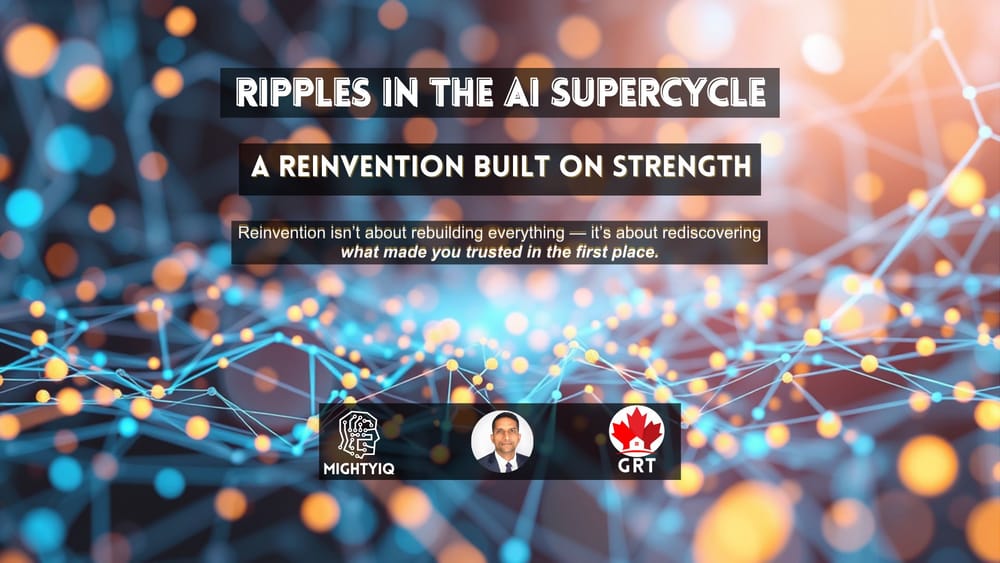Ripples in the AI Supercycle – A Reinvention Built on Strength
I studied Telecommunications Engineering, and my final-year project focused on Optical Fibre Communication — a technology that still forms the backbone of global connectivity.
Even today, fiber remains one of the most reliable and widely trusted technologies powering global connectivity.
Maybe that’s why Nokia’s story feels personal.
We all watched Nokia rise as a global telecom leader.
And we all watched it fade when smartphones reshaped the market.
Most people assumed Nokia was gone for good — another fallen giant that couldn’t adapt.
But here’s the twist —
Nokia never truly disappeared. It quietly rebuilt itself.
Not by trying to win the smartphone race again,
but by strengthening the systems the world already relies on:
networks, fiber, wireless infrastructure, and the technologies that make modern connectivity possible.

⚡ A Reinvention Built on Strength
Nokia’s comeback didn’t happen by attempting to reclaim consumer glory.
It happened by doubling down on its foundational strengths.
After exiting phones in 2013, Nokia rebuilt itself around B2B telecom infrastructure — supplying next-generation radios, network equipment, and connectivity systems to operators worldwide. It reinforced this with a massive wireless patent portfolio and continued building the fiber and deep-sea cables that carry global internet traffic.
Industry confidence surged when Nvidia invested $1B, validating Nokia’s role in powering the next era of intelligent networks.
Key Highlights
- 📡 Shifted from consumer devices to global telecom infrastructure
- 📶 Major supplier of 5G radios and network systems
- 🧠 Strong IP base with tens of thousands of wireless patents
- 🌍 Builder of fiber and deep-sea cables powering global connectivity
- 🤝 Strengthened through a strategic Nvidia partnership
- 📈 Renewed market confidence as Nokia’s transformation became clear
This reinvention wasn’t about staying relevant —
it was about rediscovering the strengths the world already trusted Nokia for.
🧩 The Bigger Story
At the recently held Brooklyn 6G Summit, Nokia’s leadership shared a powerful insight:
The future of AI won’t exist only in data centers — it will exist inside the network.
AI is moving closer to the real world through:
- autonomous vehicles
- drones
- robotics
- AR/VR
- industrial automation
- edge devices
And as AI shifts from cloud-heavy models to real-time, on-device intelligence, networks must evolve from simply carrying data to processing intelligence instantly and securely.
This is why Nokia’s partnership with Nvidia matters.
Together, they’re building AI-native networks designed for this next wave of intelligent workloads.
Nokia isn’t trying to be a consumer brand again.
It’s building the digital backbone of the AI-powered world.
💡 Why Nokia Still Matters
📶 Infrastructure Leadership — powering global telecom and 5G systems
🌐 Connectivity Backbone — fiber and undersea cables carrying global data
🧠 AI-Ready Architecture — preparing networks for real-time AI
📜 Patent Strength — decades of R&D fueling licensing revenue
🤝 Ecosystem Partnerships — Nvidia and global carriers shaping the AI-native wireless era
Nokia’s resurgence isn’t a comeback story —
it’s a strategic evolution built on engineering depth and long-term clarity.
🌱 What I Tell Startups
If you’re interested in how reinvention applies to both startups and legacy companies, you might find value in my earlier post, “Ripples in a Papercup,” where I outlined a simple framework for spotting opportunities, validating ideas, and building with discipline.
🔗 Read the earlier post: https://iamgrt.com/ripples-in-a-papercup/
♻️ Repost if you believe “The future won’t just run on AI — it’ll run on the networks behind it.”
💬 What do you think?
Is Nokia quietly shaping one of the most unexpected reinvention stories of the decade?
Or is this just the beginning of a larger shift in how the world connects and consumes AI?
🤝 Let’s Collaborate
I’m a Canada-based entrepreneur and growth strategist working at the intersection of technology, trust, and transformation — helping businesses build systems that stay relevant even as markets shift.
Stories like this one on Nokia remind us: real reinvention isn’t about chasing trends.
It’s about strengthening the foundations that innovation depends on — reliability, clarity, and long-term credibility.
If you’re building something new — an AI-driven product, a smarter platform, or a more resilient ecosystem — I’d be glad to help.
🔭 What I Focus On
🌍 Strategic Reinvention — guiding companies to reposition, evolve, and stay competitive in AI-driven markets.
🧠 Digital & Technology Transformation — aligning systems, data, and strategy for sustainable, measurable outcomes.
⚙️ Scalable Systems Design — building intelligent, dependable foundations rather than vanity-layer innovation.
🧩 How I Help
💡 Technology & Platform Strategy — advising startups and enterprises on responsible scaling across AI, cloud, and digital ecosystems.
📦 Supply Chain & Infrastructure Resilience — enabling transparency, traceability, and structured growth.
📺 Media & Content Expansion — supporting FAST, OTT, and platform-led growth with strategic clarity.
Across industries, the real competitive edge isn’t speed —
it’s credibility.
Because in every transformation, trust is the true algorithm.
🌐 Building something new?
If you’re looking for a reliable hosting provider, I’d recommend DreamHost.
We’ve used it for our client websites for over a decade — it’s fast, secure, and built for creators who want peace of mind.
🔔 Stay Connected
If this story on perspective, resilience, and transformation resonated with you, let’s keep the conversation going.
👉 Subscribe to my newsletter, Beyond Growth Playbook, for insights on strategy, technology, and transformation: iamgrt.kit.com.
⚡Build with Confidence with GRT is a focused space (WhatsApp channel) for founders and professionals seeking clarity, momentum, and practical guidance. Get sharp insights across CPG, digital transformation, AI, global trade, and growth strategy — to move faster and build smarter. https://tinyurl.com/buildGRT



